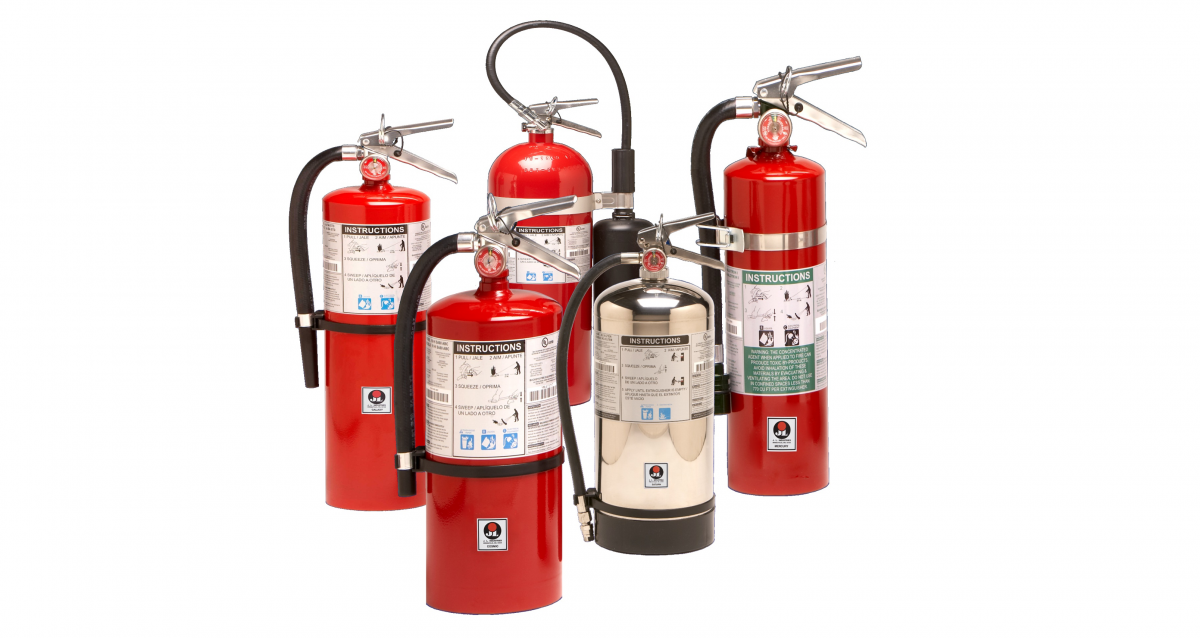
Are Cabinets Required for Fire Extinguishers?
No, as a general rule, they are not, but a cabinet can offer several benefits:
- International Building Code (IBC), International Fire Code (IFC) and National Fire Protection Association (NFPA) do not require portable fire extinguishers to be in a cabinet.
- An extinguisher in a cabinet can deter tampering and provide protection from the elements or corrosive coastal conditions. Some local codes may require cabinets to prevent theft.
- Allow the extinguisher to be recessed into a wall to meet ADA maximum 4” projection standards.
- NFPA 10 requires that fire extinguishers subject to physical damage should be protected.
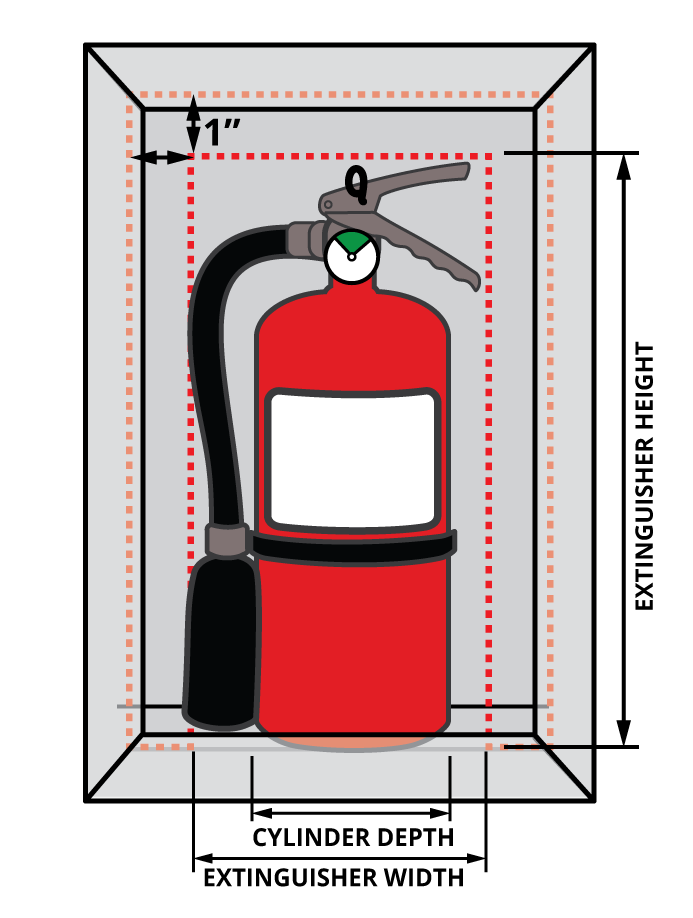
How do I Select the Right Size Cabinet?
- You will need to consider three dimensions, the total height including handle, total width including hose, and the tank diameter. Co2 extinguishers have a wide horn on the hose, requiring a wider cabinet.
- Using your three dimensions, look at the cabinet manufacturer’s data page and see which size will give you at least 1” of clearance in height, width and depth.
- Many cabinets have a door frame or stop that is slightly smaller than the interior of the cabinet, so make sure that the extinguisher can be easily re-moved from the cabinet in the case of a fire.
Does the Extinguisher Have to be Mounted on a Wall Bracket Inside the Cabinet?
No, they do not, except for bubble cabinets. Some 20 lb extinguishers must be mounted on the tub wall instead of sitting on the bottom of the cabinet in order to close the door. Read and follow the manufacturer’s installation instructions.
What Kind of Handles, Locks and Latches can be Used?
- Per IBC section 906.8 (2018), cabinets must not be locked unless they are installed where extinguishers are subject to malicious use or damage, or in security facilities with Group I-3 occupancies and in mental health areas in Group I-2 occupancies. In those cases, access to extinguishers shall be permitted to be locked or to be located in staff locations provided the staff has keys.
- Several manufacturers offer a feature that has a lock with a flexible cam, and a pull handle. These cabinets can be locked and are used as theft and tamper deterrents because they appear to need a key to be unlocked, but because of the flexible cam, the cabinet can be easily opened with a sharp pull on the handle. Cabinets equipped with that feature are not considered “locked” for code purposes.
- A “break glass” feature on a cabinet may not include a handle, but do provide a hammer or a lever that is to be used to break the glass to get into the cabinet.
- The door pull for an extinguisher cabinet is considered an “operable part” by Americans with Disabilities (ADA) standards. They must be usable with one hand and without tight grasping, pinching or twisting of the wrist, or more than 5 lbs of force.
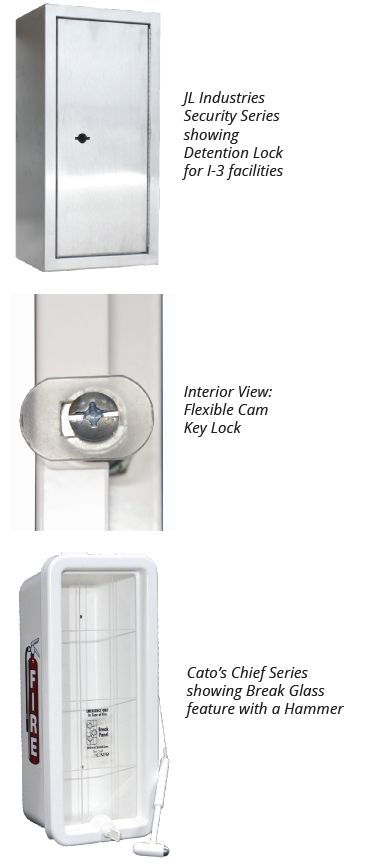
Is Lettering Required on the Cabinet?
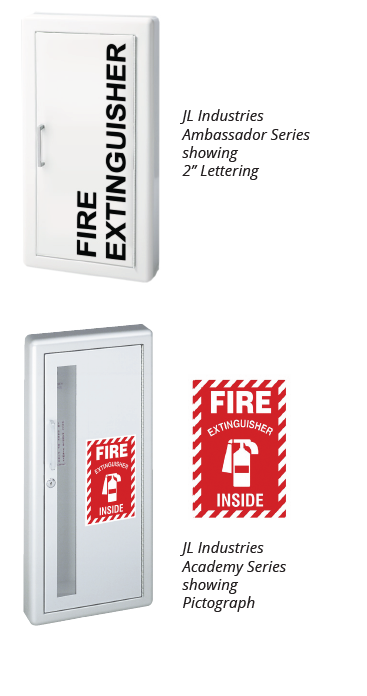
It depends – both IBC and IFC have requirements – check with your local code official about requirements in your area.
- IBC and IFC 2024 require that cabinets containing fire-fighting equipment such as standpipes, fire hoses, fire extinguishers, fire department valves shall be identified in an approved manner by a permanently attached sign with letters not less than 2” high in a color that contrasts with the background color indicating the equipment contained therein. Exceptions are; doors not large enough to accommodate a written sign, shall be marked with a permanently attached pictogram of the the equipment contained therein; doors with an approved clear glass panel or a complete glass door panel.
- Some code officials and areas require the cabinet to be labeled with decal or diecut “Fire Extinguisher” lettering regardless of the door and glass style. Check with your local code official for requirements in your area.
- Class K kitchen extinguishers in a facility with an automatic fire protection system are required by NFPA 10 section 5.5.5.3, to have a sign near the extinguisher that states that the fire protection system shall be actuated prior to using the fire extinguisher (see example below).
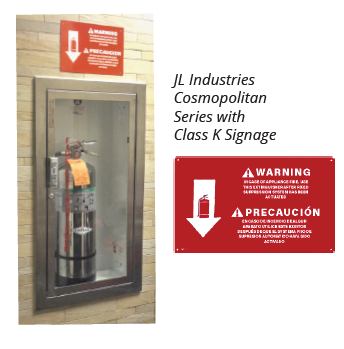
Is a full glass door required for the cabinet?
A full glass or vertical glass panel in the door allows visualization of the extinguisher inside, and also complies with IBC. IBC requires additional signage if the extinguisher is not visible – as in the case of a solid door, or small view window.
Some areas may require a bubble type glazing in the cabinet instead of flat glazing so that the contents can be easily viewed.
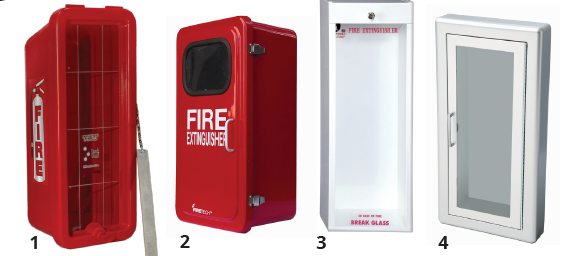
What construction material is best for a cabinet?
For indoor use, common material types include steel, stainless steel and aluminum.
For exterior use, plastic, fiberglass, galvanneal steel and aluminum cabinets can prove to be more resistant to moisture and coastal conditions. Cabinet examples Above: 1 – Cato Chief (plastic), 2 – JL Industries FB Series (fiberglass), 3 – JL Industries Classic Series (galvanneal steel), 4 – JL Industries Aluminum Academy Series.
Do I need a special cabinet if my wall is fire-rated?
Per IBC Section 714, a cabinet opening that penetrates the wall must be installed so that the fire-resistance rating is not reduced. Fire-rated cabinets are designed, tested and labeled so that you can be assured that the integrity of the wall is maintained.
Note: Article updated 6/5/2024
